Kmart, once the poor cousin of chain stores, has risen phoenix-like with improved earnings before interest and tax of 18% ($432 million) and delivered a remarkable return oncapital of almost 33% for parent Wesfarmers. The company delivered these results to the ASX yesterday and said it “remains proud and happy to be a conglomerate” after its retail businesses offset weakness in its industrial operations to lift group underlying earnings 8.3% higher in the year to June 30.
The company’s $2.44 billion net profit came on a four per cent increase in revenue to $62.4 billion and was accompanied by a fully franked final dividend of $1.11 a share.
Kmart has been resuscitated by former McDonald’s Australia chief Guy Russo, who took on the role of managing director in 2010 with no retail experience. The chain was heading for collapse at the time, was turning over $4 billion but making zero profit.
Earlier this year, Russo was interviewed by Smartcompany.com.au and revealed these insights:
Team management
“The team used to say to me “Big W’s doing this, Target’s doing that”… I’d walk into the stores and see the lines were long, the shelves were dusty and I’d think ‘How much of that time were they out there finding out about another retailer and what were they going to do with it anyway?’
That’s why, I say (to my team) stay where you are and try to convert people who are in the store.”
Distribution
Russo closed many of Kmart’s distribution centres and saved $60 million “We got people to analyse the distribution centres and compare them to the big five. So we went off to close 15.”
Discounting
He got rid of discounting and dropped prices. “Why would we want a special for customers to come in one week? Wouldn’t you want them coming in every day?”
Buying strategy
“If you are going to drop your prices you can’t have a lot of product and you only win a really low price strategy by buying something in volume. We used to sell 100,000 pairs of jeans at around $15 a pair. If I said I wanted 10 million, then the price halves. “
“ On the shop floor we found there were eight different black shirts. Then we cut back to two. All of a sudden the team didn’t have to go to eight different suppliers, eight different cities, eight different materials.”
Branding
“When we started removing brands that made people nervous. Customers talk brands, “I’ve got Hugo Boss, I’ve got Bonds,” but they go on price. The $30 jean factory and the $7 jean factory is the same factory.
Sourcing
“We got into total transparency with factories because we found the factories. That was our goal to find the factories that our suppliers were using. We started by adding staff in China.”
We are now at 400 staff [in China] so we have come a long way.
Once we found the factory we started slowly bringing in our standards. Ethical sourcing came around 2009-2010.
In [2013] we had just entered Bangladesh and a building collapsed and thousands died. That ramped up our whole ethical sourcing as we thought we have to be responsible not only for quality and labour but also facilities.
Online
“Amazon owns online. I’d say to any retailer that’s got bricks and mortar, if you’re really doing online, just make sure you focus on whether it’s giving you the right return to your shareholders. I think there are lots of companies that shouldn’t even bother.
Our online strategy and this may never happen, is to be the largest distributor of needed product anywhere in the world.”
“The team are not trying to work out how to move a $7 toaster from Bourke Street to Campbellfield… the team’s goal is we buy 700 million things, right now, from China to Kmart. Our goal online would be if Walmart, Primark, anyone, a customer living in America, could buy our $1 plates and order 20 million of them, that would be my ultimate dream with online.
“You probably won’t even know it’s Kmart if we get this right. The online one is a bold vision, that could never take off, but it’s not about trying to compete with moving stuff from Dubbo to Darwin.
DJ, Myer, Target with online are 2-3% of sales and I’ve watched all their profits, all their macro profits go backwards. I said to my team “leave it”.

